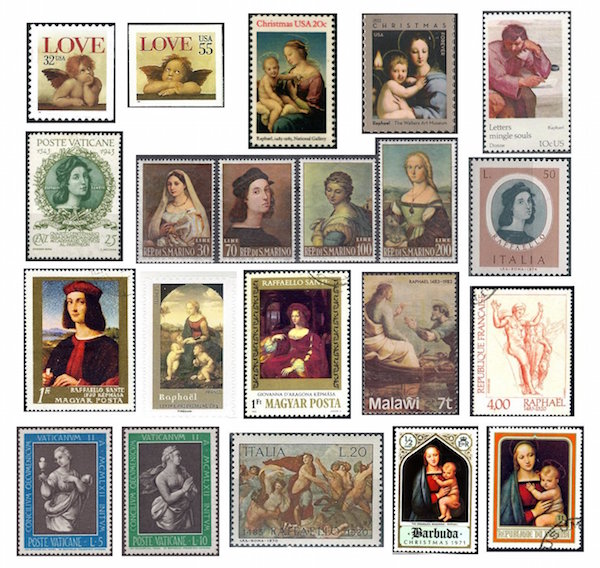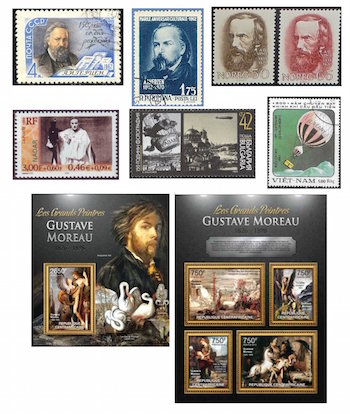The Arts on the Stamps of the World — April 6
An Arts Fuse regular feature: the arts on stamps of the world.

By Doug Briscoe
The spotlight today falls on another great Old Master, Raphael, who is profusely represented on stamps of the world. Sources differ as to his correct date of birth in the year 1483, with some citing March 28, others April 6. He died, as it happens, on April 6 in 1520, so one way or another we’re right to honor him today. I think Raffaello Sanzio da Urbino may be represented on American stamps more than any other foreign artist. You may recall seeing some of these in your travels—the Love stamps from 1995, Christmas stamps from 1983 and 2011, and a letter-writing stamp from 1974. Choosing which of the multitude of Raphael stamps to omit was again a challenge for me.
Aleksandr Herzen (April 6 [O.S. 25 March] 1812 – January 21 [O.S. 9 January] 1870), the “father of Russian socialism”, was more of a political writer than an “artist”, but his writings had a telling effect on his homeland, contributing to the eventual (1861) emancipation of the serfs. His two most significant works are the influential novel Who is to Blame? (1845–46) and his autobiography, My Past and Thoughts (1852-70). He was a brilliant thinker and a great proponent of social equality.
Norwegian poet and travel writer Aasmund Vinje (6 April 1818 – 30 July 1870) founded a periodical in 1858 that dealt with the arts, politics, language, and travel. One of the pieces he wrote for the journal, a description of the coronation of King Charles IV, is beloved in Norway for its depiction of the common people Vinje met along the way and with whom he seems more concerned than with the ostensible subject of his article. His poems also live on in the Norwegian consciousness. Edvard Grieg set many of them to music, including one of his most famous songs, “The Last Spring”.) Vinje was a pioneer in the use of Landsmål (now known as Nynorsk, or New Norwegian, one of the two official written languages of Norway).

Ever heard of Gaspard-Félix Tournacho (6 April 1820 – 23 March 1910)? You may know him better by the name “Nadar”, a diminutive version of the nickname “Tournadar” given him by his Bohemian friends (people like Baudelaire and Théodore de Banville). (Perhaps the more literate among you can decipher the pun for me, if there is one.) This extraordinary fellow, born to a printer and bookseller, studied medicine but gave it up to draw caricatures and write fiction for periodicals. He went on to found a couple of magazines of his own. In 1853 be began taking photographs and over the years to come created he photographic portraits of many of the most celebrated personalities of the day: Berlioz, Liszt, Dumas, Millet, George Sand, Jules Verne, Zola, Gounod, Sarah Bernhardt, Ernest Shackleton, Clemenceau, and on and on. The French stamp derives from a set devoted to pioneer photographers. Nadar was also fascinated with ballooning, which is the facet of his interests that has captured the attention of stamp designers from Bulgaria and Vietnam! Wikipedia takes up the tale: “In 1863, Nadar commissioned the prominent balloonist Eugène Godard to construct an enormous balloon…named Le Géant (The Giant), thereby inspiring Jules Verne’s Five Weeks in a Balloon.” On the left side of the Bulgarian stamp—issued to commemorate the 150th anniversary of photography—we see a detail from Honoré Daumier’s lithograph “Nadar élevant la Photographie à la hauteur de l’Art” (“Nadar elevating Photography to the Heights of Art”). The Vietnamese stamp, from a set on the history of ballooning, clearly shows Le Géant. Wikipedia gives us two further irresistible historical tidbits: “On his visit to Brussels with Le Géant, on 26 September 1864, Nadar erected mobile barriers to keep the crowd at a safe distance. Crowd control barriers are still known in Belgium as Nadar barriers.” And: “During the Siege of Paris in 1870–71 Nadar was instrumental in organising balloon flights carrying mail to reconnect the besieged Parisians with the rest of the world, thus establishing the world’s first airmail service.” (It may be interesting to note that Aleksandr Herzen’s first cousin Count Sergei Lvovich Levitsky was a pioneer in Russian photography.)
Our next four consecutive subjects were all painters. Two lovely souvenir sheets from the Central African Republic were the only stamps I could find celebrating the work of the important French Symbolist painter Gustave Moreau (6 April 1826 – 18 April 1898). André Breton believed that Moreau was an important precursor of Surrealism and spent many hours in the Gustave Moreau Museum in Paris where many of the earlier painter’s 8,000 works are on display. Since they can’t be seen very clearly in the available images, I provide links to expanded versions of the paintings reproduced on the stamps. Seen on the smaller of the pair is one of the best known of Moreau’s works, Oedipus and the Sphinx (1864). (Moreau’s 1850 Self-Portrait dominates the sheet.) On the sheet at right are (top row) Death Offers Crowns to Winners of theTournament (c1855-60), Le Poète voyageur (1890), (bottom row) Orpheus (1865), and Diomède dévoré par ses chevaux (1865).

Canadian painter and sculptor Marc-Aurèle de Foy Suzor-Coté (April 6, 1869 – January 29, 1937) was born in Quebec and is held to be one of the first native-born Canadian artists to embrace Impressionism in his work. He studied in Paris, not only art, but also music as a budding baritone. He returned to Canada in 1908 and set up a studio in Montreal. Sadly he suffered paralysis in 1927 and spent the last years of his life in Daytona Beach. The Canadian stamp of 1969 shows his Return from the Harvest Field of 1903.
Our third consecutive painter was the Cuban Jorge Arche (April 6, 1905 – November 9, 1956). Online information about him is rather scarce. I know he died at the age of 51 in Cádiz, Spain but not the cause. The Canadian poet David W. McFadden writes of Arche in his poem “The Death of Greg Curnoe”:
I fall in love with the paintings of Jorge Arche
and take great pains to photograph them
because no reproductions are available
nobody knows anything about Jorge Arche…
Well, pace McFadden, a few small reproductions are available in the form of postage stamps issued by Cuba in 1977: the lovely Portrait of Mary (El retrato de Mary, 1938), a picture of Cuban national hero José Martí [1/28], a portrait of his friend Aristides Fernandez (1933), the striking, rather Gauguinesque Bañistas (Bathers, I couldn’t find a date for this), Mi mujer y yo (My Wife and I, 1937), and a Self-Portrait.
Born 102 years ago today was Polish visual and theater artist Tadeusz Kantor (6 April 1915 – 8 December 1990). He was related through his mother to the composer Krzysztof Penderecki. During the occupation of World War II, Kantor founded the underground Independent Theatre, a crucible in which his later experimental ideas were formed. Ten years after the war he established a new theater group called Cricot 2. Among his more successful productions were plays by Stanisław Witkiewicz (aka “Witkacy”). In 1977, Andrzej Wajda directed a version for television or Kantor’s revolutionary Dead Class (1975). His works were popularized in the United States in the 1990s through the efforts of Ellen Stewart’s La MaMa Experimental Theatre Club.

It’s also Francis Ford Coppola’s birthday today. He’s 78. Having already shown the Godfather stamp twice in the last two weeks for the birthdays of James Caan and Marlon Brando, I’m giving it a rest today.
I found it an interesting coincidence that two epigrammatists (albeit without stamps) share this birthday: Jean-Baptiste Rousseau (6 April 1671 – 17 March 1741; not to be confused with Jean-Jacques Rousseau), a playwright and poet, and Sébastien-Roch Nicolas, known as Chamfort (1741 – 13 April 1794). It’s also the birthday of American writer Donald Barthelme (April 7, 1931 – July 23, 1989).
A graduate of the University of Massachusetts with a B.A. in English, Doug Briscoe worked in Boston classical music radio, at WCRB, WGBH, and WBUR, for about 25 years, beginning in 1977. He has the curious distinction of having succeeded Robert J. Lurtsema twice, first as host of WGBH’s weekday morning classical music program in 1993, then as host of the weekend program when Robert J.’s health failed in 2000. Doug also wrote liner notes for several of the late Gunther Schuller’s GM Recordings releases as well as program notes for the Boston Classical Orchestra. For the past few years he’s been posting a Facebook “blog” of classical music on stamps of the world, which has now been expanded to encompass all the arts for The Arts Fuse.

